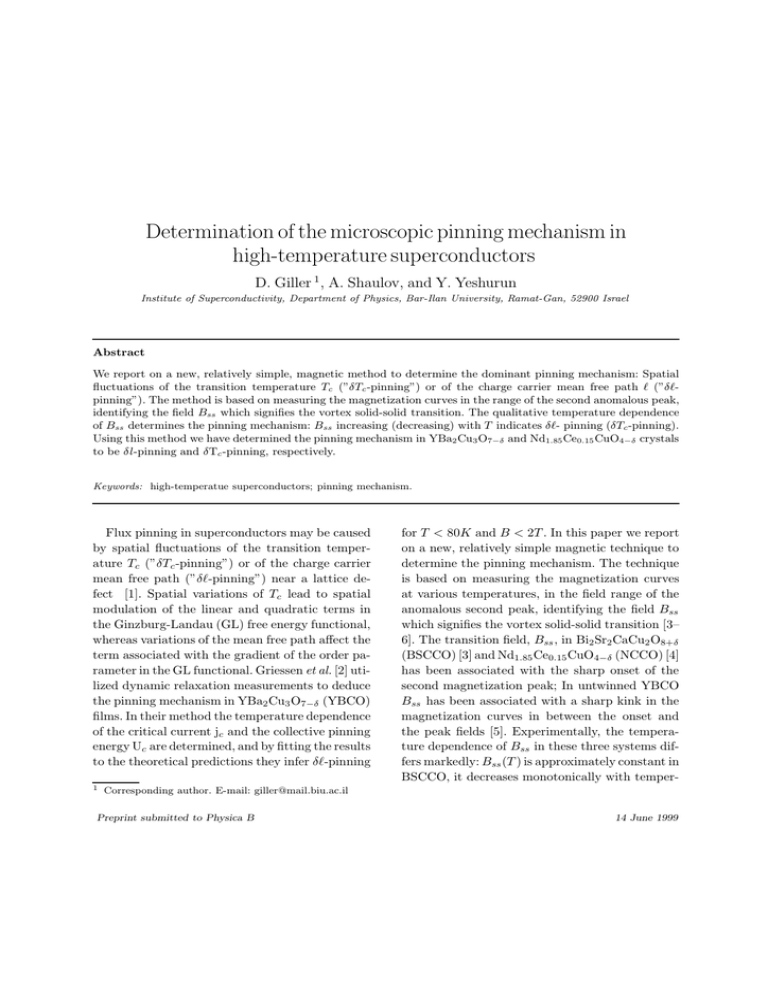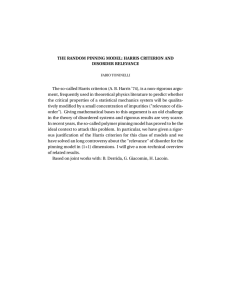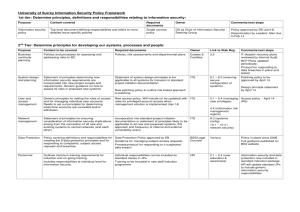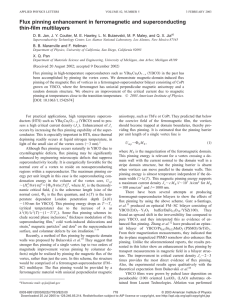Determination of the microscopic pinning mechanism in high-temperature superconductors D. Giller
advertisement

Determination of the microscopic pinning mechanism in high-temperature superconductors D. Giller 1 , A. Shaulov, and Y. Yeshurun Institute of Superconductivity, Department of Physics, Bar-Ilan University, Ramat-Gan, 52900 Israel Abstract We report on a new, relatively simple, magnetic method to determine the dominant pinning mechanism: Spatial fluctuations of the transition temperature Tc (”δTc -pinning”) or of the charge carrier mean free path ` (”δ`pinning”). The method is based on measuring the magnetization curves in the range of the second anomalous peak, identifying the field Bss which signifies the vortex solid-solid transition. The qualitative temperature dependence of Bss determines the pinning mechanism: Bss increasing (decreasing) with T indicates δ`- pinning (δTc -pinning). Using this method we have determined the pinning mechanism in YBa2 Cu3 O7−δ and Nd1.85 Ce0.15 CuO4−δ crystals to be δl -pinning and δTc -pinning, respectively. Keywords: high-temperatue superconductors; pinning mechanism. Flux pinning in superconductors may be caused by spatial fluctuations of the transition temperature Tc (”δTc -pinning”) or of the charge carrier mean free path (”δ`-pinning”) near a lattice defect [1]. Spatial variations of Tc lead to spatial modulation of the linear and quadratic terms in the Ginzburg-Landau (GL) free energy functional, whereas variations of the mean free path affect the term associated with the gradient of the order parameter in the GL functional. Griessen et al. [2] utilized dynamic relaxation measurements to deduce the pinning mechanism in YBa2 Cu3 O7−δ (YBCO) films. In their method the temperature dependence of the critical current jc and the collective pinning energy Uc are determined, and by fitting the results to the theoretical predictions they infer δ`-pinning 1 for T < 80K and B < 2T . In this paper we report on a new, relatively simple magnetic technique to determine the pinning mechanism. The technique is based on measuring the magnetization curves at various temperatures, in the field range of the anomalous second peak, identifying the field Bss which signifies the vortex solid-solid transition [3– 6]. The transition field, Bss , in Bi2 Sr2 CaCu2 O8+δ (BSCCO) [3] and Nd1.85 Ce0.15 CuO4−δ (NCCO) [4] has been associated with the sharp onset of the second magnetization peak; In untwinned YBCO Bss has been associated with a sharp kink in the magnetization curves in between the onset and the peak fields [5]. Experimentally, the temperature dependence of Bss in these three systems differs markedly: Bss (T ) is approximately constant in BSCCO, it decreases monotonically with temper- Corresponding author. E-mail: giller@mail.biu.ac.il Preprint submitted to Physica B 14 June 1999 BSCCO [7], Bss initially increases with temperature, suggesting a δ`-pinning mechanism at low temperatures in these samples. In summary, the markedly different temperature dependence of the vortex solid-solid phase transition lines in BSCCO, NCCO and YBCO is directly related to the different pinning mechanisms in these systems. Using this method we have determined the dominant pinning mechanism in YBCO and NCCO crystals to be δ`-pinning and δTc -pinning mechanism, respectively. The low temperature data for oxygen-doped BSCCO also indicate δ`-pinning mechanism. <%&2 1&&2 77F %>N*@ %>*@ %6&&2 Fig. 1. The vortex solid-solid transition line in BSCCO, NCCO, and YBCO crystals. Solid lines are theoretical fits. ature in NCCO, and it increases with temperature in the untwinned YBCO. These differences can be explained quantitatively within the framework of a recent theory [6] describing a mechanism for a disorder-induced phase transition, from a relatively ordered vortex lattice, to a highly disordered vortex solid. The essence of this theory is that the vortex solid-solid phase transition is determined by the interplay between the vortex elastic energy Eel and the pinning energy Epin . The transition line Bss , as defined by Eel (B, T ) = E pin (B, T ), depends strongly on the specific microscopic pinning mechanism. Detailed calculations show that for δTc -pinning Bss decreases monotonically with T , whereas for δ`-pinning Bss increases with T . Thus, the two pinning mechanisms are borne out in the experiment in the behavior of Bss (T ). Figure 1 shows the experimental data for Bss (T ) in BSCCO, NCCO, and untwinned YBCO crystals. The solid lines show fit to the theory (see [5] for details). The increase of Bss with temperature observed in YBCO indicates a δ`-pinning mechanism, in agreement with the conclusions of Griessen et al. [2]. The decrease of Bss with temperature observed in NCCO indicates a δTc -pinning mechanism. For BSCCO Bss is found only at relatively low temperatures, over a small range of T /T c , and therefore it shows no temperature dependence. In this particular case the data is inconclusive regarding the pinning mechanism as one may fit the data with either mechanism. We note that in some BSCCO samples, e.g. oxygen-doped and electron irradiated Acknowledgement This work was partially supported by The Israel Science Foundations and by the Heinrich Hertz Minerva Center for High Temperature Superconductivity. Y. Y. and A. S. acknowledge support from the German Israeli Foundation. D. G. acknowledges support from the Clore Foundation. References [1] G. Blatter et al., Rev. Mod. Phys. 66, 1125 (1994). [2] R. Griessen et al., Phys. Rev. Lett. 72, 1910 (1994); A. J. J. van Dalen et al., Phys. Rev. B 54, 1366 (1996). [3] B. Khaykovich et al., Phys. Rev. Lett. 76, 2555 (1996). [4] D. Giller et al., Phys. Rev. Lett. 79, 2542 (1997). [5] D. Giller et al., Phys. Rev. B (in press). [6] D. Ertas and D. R. Nelson, Physica C 272, 79 (1996); T. Giamarchi and P. L. Doussal, Phys. Rev. B 55, 6577 (1997); V. Vinokur et al., Physica C 295, 209 (1998); J. Kierfeld, Physica C 300, 171 (1998). [7] M. F. Goffman et al., Phys. Rev. B. 57, 3663 (1998); D. T. Fuchs et al., Phys. Rev. Lett. 80, 4971 (1998); B. Khaykovich et al., Phys. Rev. B 56, R517 (1997). 2






